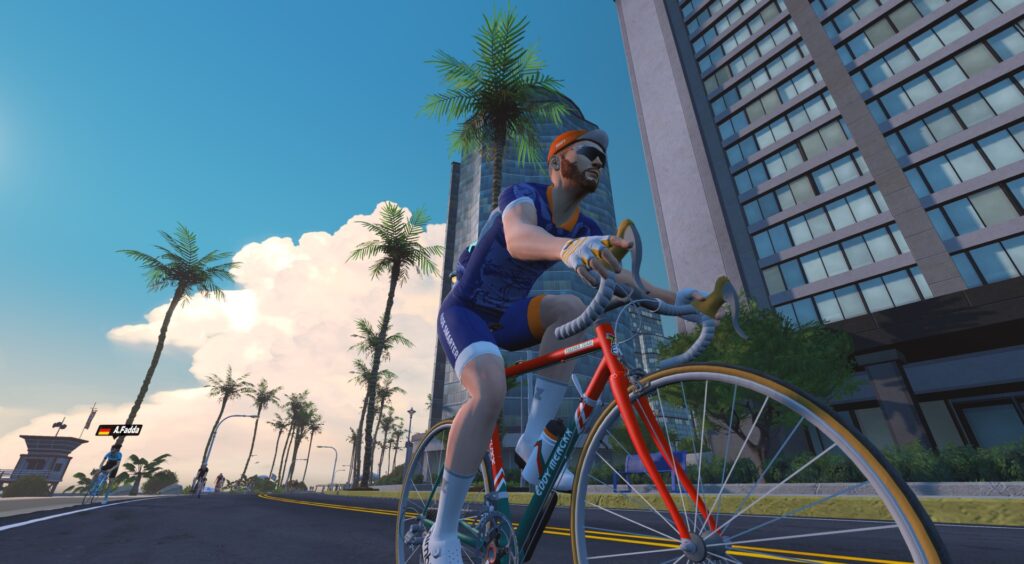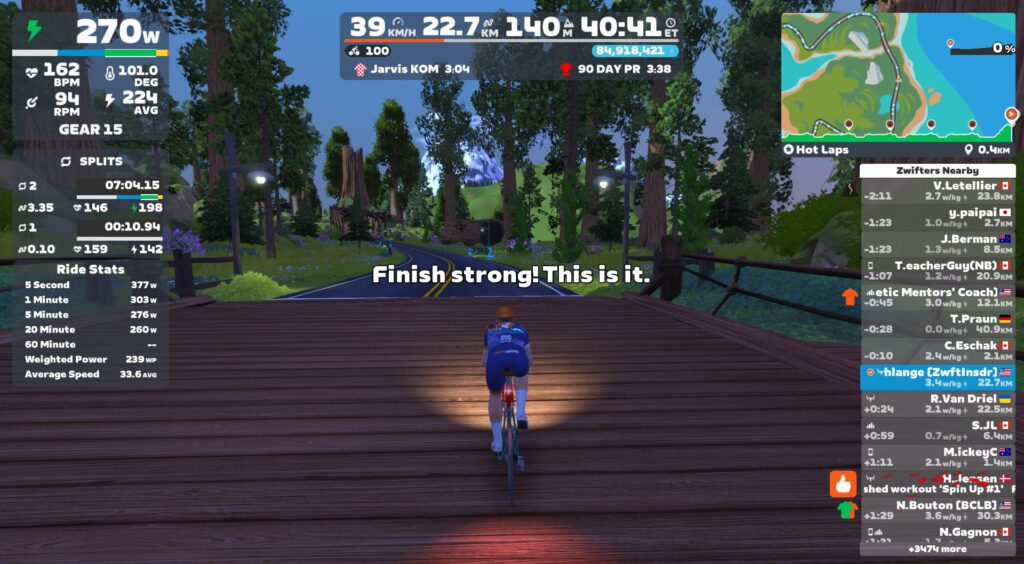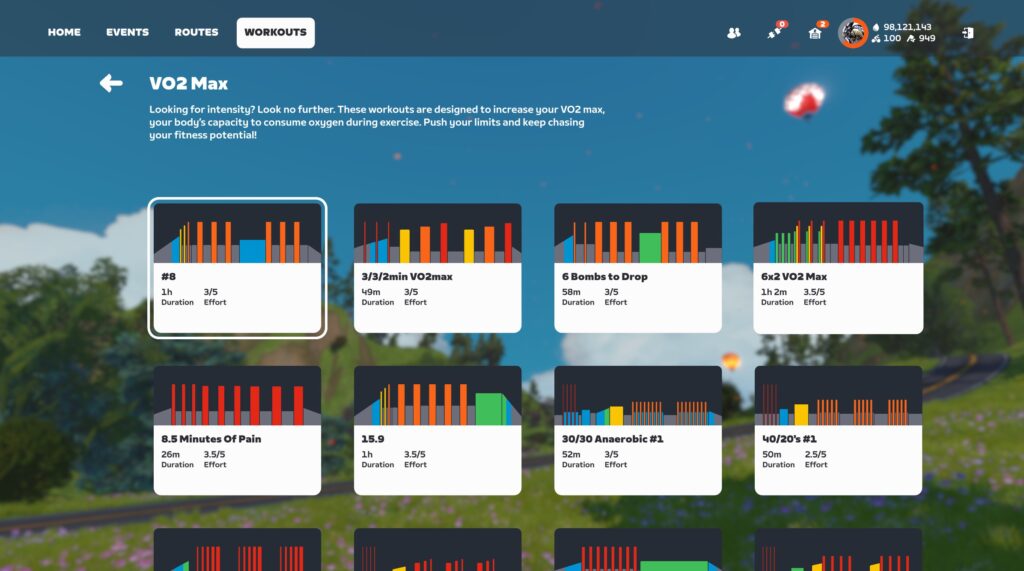Zwift Camp: Build is now underway. This is a 5-stage route-based workout series, with each stage lasting one week and focusing on developing power over a specific time interval.
My plan is to do each of the five workouts before their weeks begin, so I can write a post unpacking the workout and delivering some tips along the way. This post covers Stage 3’s workout on Watopia’s new Hot Laps route. Let’s roll!

Stage 3 Walkthrough: Chase Your Rival
The third stage of Zwift Camp: Build is focused on “Three 5-minute efforts” according to the event description. But it’s probably not laid out how you’d expect!
The stage is built around the new Hot Laps route in Watopia, which takes riders on 4 full laps of the Volcano Circuit, followed by a finish up the Jarvis KOM:
Follow the instructions on screen and you’ll use the first lap as a warmup and a bit of recon, learning where that little kicker is at, where you can recover a bit on descents, etc. The instructions have you begin your effort in earnest at the start of the second lap, and there are really two stated goals here:
- Put in a hard, steady effort on laps 2, 3, and 4 while also
- Negative splitting your lap times (that is, going faster each lap)
So you don’t want to start off with a maximal effort on lap 2, because you won’t be able to beat that effort the next lap!
My legs were tired from a metric century the day before, so I just targeted power numbers I knew I could hold:
- Lap 2: 250W
- Lap 3: 260W
- Lap 4: 270W
I also kept an eye on my previous effort HoloReplay, making sure I beat him each lap.
You might think it would be hard to manage your power well enough to precisely hit power targets, but thanks to the average power number on the Splits HUD, I found it pretty easy. I was bang on my target for laps 2 and 3, then pushed extra hard on lap 4 just because I could, coming in a few watts above my 270W target.
What power targets should you shoot for? You won’t be able to hold true VO2 max power for three continuous laps, but if your legs are fresh, you should be able to push at or just above your FTP for all three laps. Something like this should be doable with fresh legs:
- Lap 2: 100% of FTP
- Lap 3: 103% of FTP
- Lap 4: 106% of FTP
Or you could skip trying to hit a power target, and simply try to stay away from your previous effort HoloReplay every lap. Put in a hard but not maximal effort on lap 2, then just make sure you beat your HoloReplay on laps 3 and 4!
After finishing the fourth lap, the route takes you into Jarvis for a finishing effort up the Jarvis KOM. This short climb will take most riders 3.5-5 minutes to complete, so it’s actually a proper traditional VO2 max interval in terms of its length and the 5 minutes of recovery you get just before it begins. My advice? Just empty the tank. It’s the end of the workout, so put in a maximal effort up that KOM segment and see what you can do!
Overall, I found this the most fun Zwift Camp: Build stage yet. The challenge of pacing myself so I was both working hard but also negative splitting the laps kept me engaged, even if my tired legs didn’t let me ride anywhere near VO2 max targets. And while the HoloReplay bug persists (see below), my previous effort ghosts proved very motivating!
Drafting Note
Your previous effort ghost is an exact replay of your avatar from the previous lap, which means if you drafted on the previous lap, that ghost is moving at the speeds you attained while drafting.
This could make things difficult when you try to beat your ghost on the next lap, and you aren’t drafting.
It worked out fine for me in my on-demand workout, even though I was on a road bike, as I never drafted for a meaningful length of time. But basically, you’ll want to be either drafting most of the time, or not drafting most of the time. One simple way to make sure you don’t draft: ride a TT bike! It looks like they’re allowed in the events, and of course you can always use a TT bike in an on-demand ride.
What Is This Workout?
After Stage 1’s short neuromuscular sprint efforts, and Stage 2’s longer anaerobic sprints, you might expect stage 3 to focus on VO2 max power. And it does… sort of. Since the three laps are back-to-back-to-back, you won’t get the rest/recovery needed to execute traditional VO2 max intervals. Instead, you can work at pacing yourself at or just above FTP, finishing with a maximal effort on lap 4, then recovering a bit before doing one more hard VO2 max interval up the Jarvis KOM.
It’s not a traditional VO2 max workout, but it’s engaging and fun work. Plus, pacing the three Volcano Circuit laps for negative splits is good practice for Stage 4’s effort up The Grade. (Turning in your best effort on that climb really comes down to pacing it well, and starting a bit below your power target while finishing a bit above it is the best way to make that happen.)
Watch My Video
More On VO2 Max Power
VO2 max measures the maximal amount of oxygen your body can consume. It is a key measure of aerobic capacity and thus a key determinant of performance potential (read much more in this TrainerRoad post). A few interesting things about VO2 max:
- Genetics play a significant role in VO2 capacity, but untrained athletes can often improve by as much as 25%.
- You might think that lung volume is what drives VO2 max, but in fact it’s largely determined by four factors: cardiac output (how much blood the heart can move), the oxygen-carrying capacity of that blood, the circulatory system itself, and muscular efficiency.
- Strong anaerobic performance is particularly useful in “spiky” cycling disciplines like cyclocross, crits, and MTB racing
- While world-class male cyclists have a VO2 max in the 75-90ml/kg/min range (recent studies are saying Tadej Pogačar may have the highest VO2 max of any winner in TdF history at 96ml/kg/min), mere mortals (good amateurs) are closer to 65-80ml/kg/min.
VO2 Max Training Tips

Traditional VO2 max training has you executing repeating intervals that are 2-6 minutes long, each 106-120% of your FTP, with very easy rest intervals in between roughly the same length as the VO2 max interval.
But there are other ways to do VO2 max work. Zwift has a “VO2 Max” folder in its workout directory, with 37 workouts to choose from at the time of this post:

Some of these workouts feature the more traditional, longer VO2 max intervals, while others have you doing high numbers of much shorter intervals (20-30 seconds). The important thing is accumulating time working at VO2 max levels.
You might also try Zwift Insider’s popular Saturday Tiny Races. This is a set of 4 short races completed in under an hour, making it basically a VO2 max workout disguised as a race.
Lastly, hill repeats are a classic outdoor VO2 max workout. Find a climb you can finish in 3-6 minutes, then hit it hard. Turn around at the top, taking your time coming down so you can recover nicely, then do it again. Aim for at least 4 repeats.
Suggestion Box
The third workout of Zwift Camp: Build was my favorite yet, even if my legs weren’t very fresh. Still, there were some things Zwift could change to improve the experience. Here are my suggestions:
- Clean Up Lap Splits: Unlike stages 1 and 2, the Splits HUD was really useful for this workout. But there are two tweaks that would make it better: making sure splits finish right at the lap arch (the first few fire early, the last fires late), and keeping the Splits HUD up even after you finish the final volcano lap.
- Fix HoloReplays: I set up my HoloReplay settings as suggested, to only show a single ghost from my previous effort. But it still showed two ghosts every time, from two different efforts, even though both were labeled “Previous.” Fix it, Zwift!
- Improve the event description: I already mentioned this for earlier stages, but once again, a simple line or two in the event description would clarify what people are signing up for. The current description for this workout (“Target Effort: Three 5-minute efforts”) really isn’t accurate at all. It’s misleading at best.
Sign Up For Stage 3
Sign up for stage 3 events in-game, in the Companion app, or go to zwift.com/events/tag/zwiftcampbuild2025wo3.
Questions or Comments?
Have you done this workout yet? Share your thoughts below, or any questions you may have heading into the workout.
